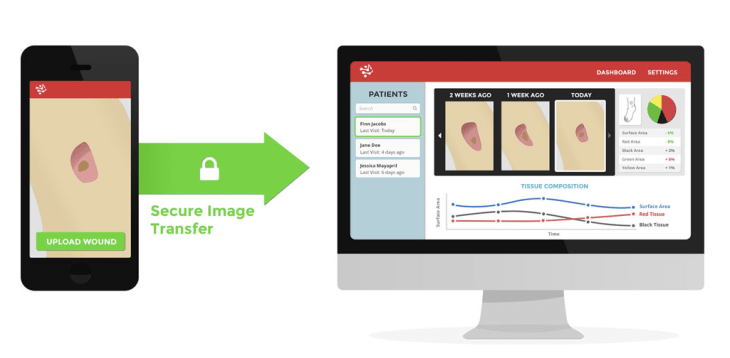Another investment for Chinese Internet giant Tencent: it’s led a $750,000 seed funding round in Baltimore-based Tissue Analytics. Existing investor DreamIt Health — the Philadelphia-based accelerator program for medtech startups which Tissue Analytics went through last July (taking pre-seed funding via that program) also participated in the round, along with several healthcare angels also from the Philadelphia area.
Tissue Analytics is focusing on the niche area of chronic wound care, such as bedsores and diabetic ulcers, using a smartphone app’s camera as a more objective tool for measuring and quantifying wound healing.
“We are a wound imaging and telehealth company, predominantly. So we look at a very small sub-set of medicine called chronic wounds,” says co-founder Kevin Keenahan. “This field is sort of archaic in the way patients are managed, it’s been a very traditionally underserved area of medicine. We’re trying to modernize it by increasing the care co-ordination capabilities but also find a more objective way to evaluate these wounds.”
The idea for the business came after the founders spent time on a grad program for medtech innovation — which gets engineers to rotate through different clinical environments to identify problems that could also be business opportunities.
“The only good way that doctors or nurses have today to demonstrate that a wound is healing is using a ruler to measure the dimensions of the wound,” he adds. “This technique is so variable and prone to error — the measurement is so noisy that doctors can’t actually determine if a wound is healing, or if the treatment’s working, so they kind of just rely on guess work. And visual approximation. So we want to bring a decimal level of understanding of the actual status of wound healing.”
Tissue Analytics’ approach allows for wound data to be collected via its smartphone app by the nurses who Keenahan says typically manage these sorts of patients in nursing homes and home care groups, and then have that data sent automatically to its web portal — where specialist doctors are able to log in to manage multiple patients remotely.
So it’s a telemedicine tool with Tissue Analytics’ aim being to bring a radiology-style approach to the field of chronic wound care. “The whole idea behind the concept is to try to make wound-care more like radiology where one specialist can manage patients from all across the region,” he notes.
“From a photo, right now, we can determine the surface area [of a wound], the contraction rates, the length and width measurements — so most of what the nurses would do today — and we do segment tissues. We don’t put clinical labels on them at this point but we can actually present some more advanced information to clinicians today,” he adds.
The startup’s technology is currently focused on enabling the gathering of accurate wound data via smartphone so human specialists can make decisions about patient care, however Keenahan says it sees potential for the technology to take on more of a diagnostic role in future.
“We are walking a line as far as being a diagnostic device,” he tells TechCrunch. “I guess there’s two phases; what we can launch immediately, and what we are collecting data for for future regulatory submissions. What we’re launching immediately is some more basic processing — it’s a lot around color correction, and simple measurements. All the future work that we’re doing is much more around predictive analytics and making a diagnosis — a specific diagnosis — about the status of wound healing. And eventually even suggesting therapies.”
The team behind the app spun out of the Center for Bioengineering Innovation & Design at Johns Hopkins University in spring 2014 — having worked on the underlying image analysis techniques as part of their thesis at the university — launching a limited beta version of the app at Johns Hopkins last November, and rolling out a more open beta this April. Customer numbers are not being broken out at this point.
Keenahan says the new funding will largely be used for a study it’s doing in conjunction with Penn Medicine to evaluate the economic impact of its system — which ultimately will form its SaaS sales pitch to healthcare and insurance companies.
“We’re looking at… total wound healing time, the rate of wound closure, we’re looking at hospital readmissions, we’re looking at infection rates, amputation rates, and then… the total healthcare expenditures. So hopefully we’ll be able to tip the needle on the majority of those categories,” he notes.
While the initial focus for Tissue Analytics is the U.S. market, Keenahan is keen to point out the impact of chronic wounds in emerging markets — and the potential for the technology to be applied more widely. “One of the aspects we’re particularly excited about is the tremendous impact that diabetic ulcers have in the developing world,” he says, noting what can be far higher health costs of managing the condition in a country like India vs the U.S., for example.
“We are really excited in working with some of the companies in [Tencent’s] portfolio that could help us start to look at the developing world as a real market,” he adds.
